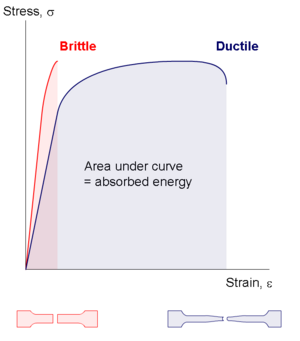Brittleness facts for kids
When we say something is brittle, it means it breaks easily without bending or stretching much first. Think of a glass dropping on the floor – it shatters into many pieces. That's because glass is a brittle material. It doesn't bend or change shape much before it breaks.
Brittle materials don't absorb a lot of energy before they break. Even if they are very strong, they can still snap suddenly. When they break, you often hear a sharp snapping sound.
In the world of materials science (which is the study of materials), a material is called brittle if it breaks with very little or no permanent change in its shape. If you could put the broken pieces back together, they would fit perfectly, because the material didn't stretch or deform before it snapped.
Contents
Why Some Materials Are Brittle
Different materials behave differently when you put force on them. Here's why some are brittle:
Polymers
Polymers are like plastics. How brittle they are can change a lot with temperature. For example, a type of plastic called poly(methyl methacrylate) (which is used in things like clear plastic sheets) is very brittle when it's cold, around 4 degrees Celsius. But if you warm it up, it becomes less brittle and can bend more.
Some polymers are called amorphous polymers. They can act like different things at different temperatures:
- When it's cold, they are stiff and brittle, like glass.
- At medium temperatures, they become more like rubber.
- When it's hot, they can become like a thick liquid.
This changing behavior is called viscoelastic behavior. In their "glassy" state, these polymers are hard and brittle. As they get warmer, they become less brittle.
Metals
Some metals are brittle because of how their tiny parts (atoms) are arranged and how they can slide past each other. This sliding is called a "slip system."
- Metals with many slip systems can deform (change shape) more easily without breaking. This makes them less brittle.
- Metals with only a few slip systems can't deform much. This makes them more brittle.
For example, metals with a hexagonal close-packed (HCP) structure often have few slip systems, so they tend to be brittle.
Ceramics
Ceramics, like pottery or porcelain, are usually very brittle. This is because it's hard for their internal structure to slide or deform. There are very few "slip systems" in crystalline ceramics that allow for movement. This makes it difficult for them to bend or stretch, so they break easily.
Also, ceramic materials often have ionic bonding. This means they are made of charged particles (ions) that repel each other if they get too close. This repulsion makes it even harder for the material to deform without breaking, adding to their brittleness.
Making Materials Less Brittle
Materials can be changed to become more or less brittle.
Toughening Materials
When a material is pushed to its limit, it can either deform (change shape) or fracture (break).
- A metal that naturally bends easily can be made stronger by making it harder for its parts to slide. But if you make it too strong, it might just break instead of bending, becoming brittle. So, making a material tougher is a balancing act.
Materials that are naturally brittle, like glass, can be made tougher. Most ways to do this involve two main ideas:
- To stop or absorb a growing crack.
- To create special internal forces that close cracks.
An example of the first idea is laminated glass. This is made of two sheets of glass with a special plastic layer (called polyvinyl butyral) in between. If the glass cracks, the plastic layer absorbs the energy and stops the crack from spreading.
The second idea is used in toughened glass (like car windshields) and pre-stressed concrete. These materials are made with internal forces that push against where cracks might start, keeping them closed. A famous example that shows how glass can be toughened is a Prince Rupert's Drop.
Brittle polymers can also be made tougher by adding tiny metal particles. When the material is stressed, these particles help create many tiny cracks that absorb energy, making the material stronger. A good example is high impact polystyrene (HIPS), which is used in things like toy parts.
Some of the least brittle structural ceramics are silicon carbide (which is very strong) and zirconia that has been specially treated to become tougher.
Another way to make materials tougher is used in composite materials. For example, strong but brittle glass fibers can be mixed into a softer, more flexible material like polyester resin. When this composite material is stretched, many tiny cracks form where the glass fibers meet the resin. These cracks absorb a lot of energy, making the whole material much tougher. The same idea is used to make metal matrix composites.
Effect of Pressure
Generally, if you put a material under a lot of pressure, its "brittle strength" can increase. This means it can handle more force before breaking in a brittle way. For example, deep inside the Earth's crust, about 10 kilometers down, rocks become less likely to fracture and more likely to deform slowly, like a very thick liquid. This is because of the immense pressure.
Crack Growth
Sometimes, cracks in brittle materials can move incredibly fast, even faster than the speed of sound in that material! This is called Supersonic fracture. Scientists first discovered this amazing phenomenon at the Max Planck Institute for Metals Research in Germany and IBM Almaden Research Center in California.
Images for kids
See also
 In Spanish: Fragilidad para niños
In Spanish: Fragilidad para niños





